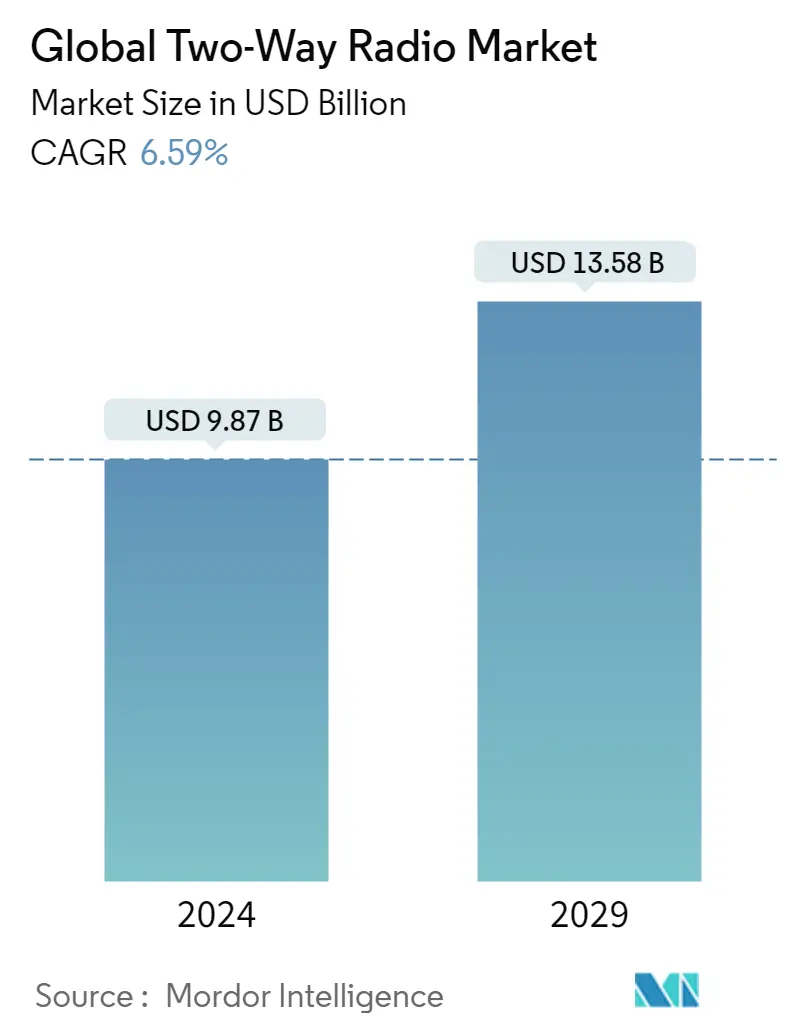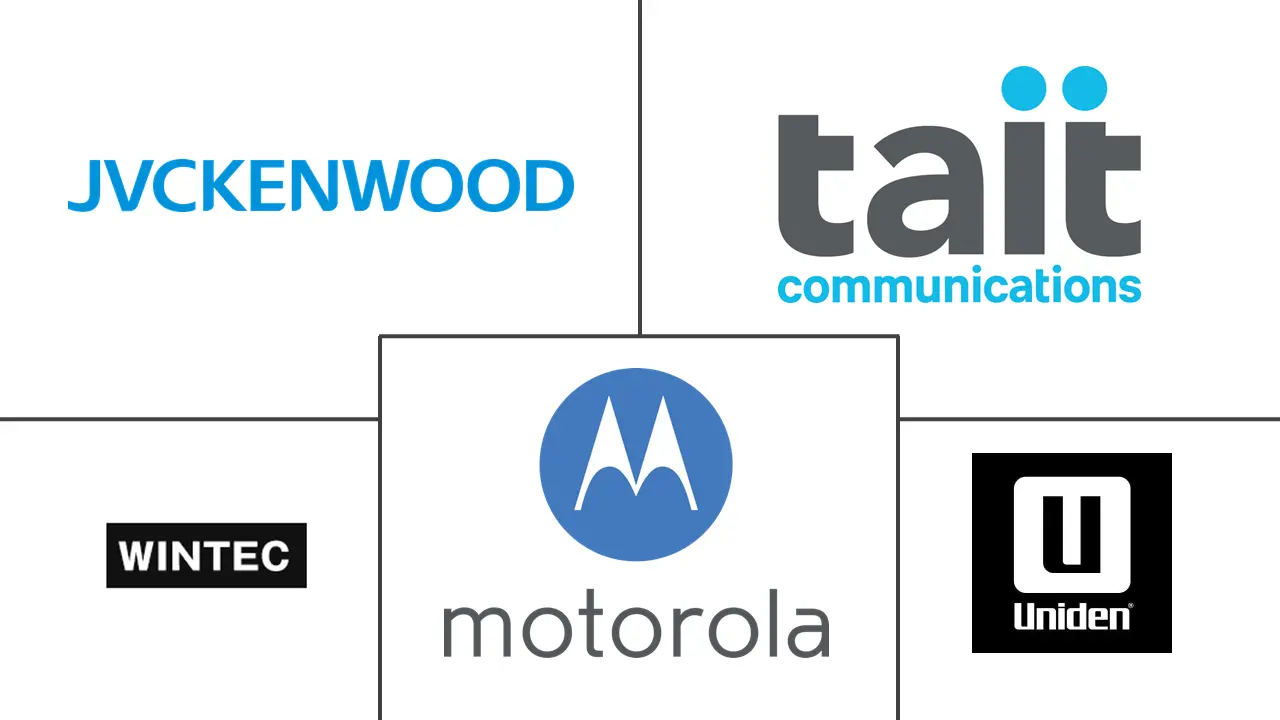Market Size of Global Two-Way Radio Industry

| Study Period | 2019 - 2029 |
| Market Size (2024) | USD 9.87 Billion |
| Market Size (2029) | USD 13.58 Billion |
| CAGR (2024 - 2029) | 6.59 % |
| Fastest Growing Market | North America |
| Largest Market | North America |
Major Players
*Disclaimer: Major Players sorted in no particular order |
Two-Way Radio Market Analysis
The Global Two-Way Radio Market size is estimated at USD 9.87 billion in 2024, and is expected to reach USD 13.58 billion by 2029, growing at a CAGR of 6.59% during the forecast period (2024-2029).
The demand for reliable and real-time communication is growing as business prospects expand. Additionally, expanded channel capacity, longer range coverage, improved voice quality, longer battery life, GPS tracking, and trucking are some of the primary advantages driving the adoption of two-way digital radio. A digital two-way radio system improves the radio communications system's performance and efficiency. It provides access to various integrated applications and solutions that can unify communications from beginning to end, revolutionizing how businesses operate.
- Military spending is increasing worldwide due to various factors, including more combat, increased government measures to enhance the military and defense sector, and increased terrorism. For the first time in 2021, global military spending reached two trillion dollars, reaching USD 2113 billion. According to Stockholm International Peace Research Institute figures, global spending in 2021 was 0.7 percent more than in 2020 and 12 percent higher than in 2012. (SIPRI). For instance, in June 2021, The US Army requested a bulk of the network modernization increase of USD 228 million for the handheld, manpack, and small form fit (HMS) radio program.
- The transportation and logistics sector is all based on tight deadlines and time scales, whether companies use trains or buses or goods being transported from A to B. Everything should be supplied when and where customers expect it. Meeting those expectations necessitates consistent, clear voice and data communication throughout the supply chain, from the warehouse to the delivery point. Drivers who can speak without being distracted safely.Instantaneous, dependable two-way radio communication assists delivery and logistics companies in streamlining operations and controlling costs.
- Hospital workers use radios to communicate with security to deescalate hostile situations and facilitate patient care across units and departments. Stadium and hospitality security officers rely on excellent communication to maintain crowd control and day-to-day operations and deliver successful events as venues return to full capacity. Administrators and security officials in schools use radios to manage the safe arrival and departure of kids through different entrances.
- For example, During the pandemic and civic unrest of 2020, the need for interoperable and fast communication during emergencies was heightened at Sinai Chicago, a network of four hospitals on Chicago's West and Southwest sides. The hospitals upgraded to a digital radio system, allowing them to increase their incident command and day-to-day operations chat groups.
- Before the COVID-19 epidemic, two-way radio equipment surged to improve staff communication on the floor and ensure safety. The advent of the COVID-19 pandemic, on the other hand, caused disruptions in several areas, including manufacturing, transportation and logistics, education, and retail. Several government initiatives to combat the virus's spread, such as travel restrictions and social isolation, resulted in the temporary closure of retail stores, manufacturing plants, and educational institutions, negatively impacting the two-way radio equipment market in the first two quarters of 2020.
Two-Way Radio Industry Segmentation
The term "two-way radio" refers to a technology that allows people to communicate with one other via radio waves. Each user is provided with a radio unit that transmits and receives voice and data over radio waves. A two-way radio system can be as simple as two radios connected directly to each other or as complicated as an encrypted nationwide network. The Global Two-Way Radio Market is segmented by Type ( Analog, Digital), End User Industry ( Business Use ( Government and Public Safety, Utilities, Industry, and Commerce), Private Use ), and Geography.
| By Type | |
| Analog | |
| Digital |
| By End User Industry | |||||
| |||||
| Private Use |
| By Geography | |
| North America | |
| Europe | |
| Asia-Pacific | |
| Rest of the World |
Global Two-Way Radio Market Size Summary
The global two-way radio communication market is experiencing significant growth, driven by the increasing demand for reliable and real-time communication across various sectors. The market is characterized by the adoption of digital two-way radio systems, which offer enhanced features such as expanded channel capacity, longer range coverage, improved voice quality, and GPS tracking. These advancements are revolutionizing communication methods in industries such as military, transportation, logistics, healthcare, and construction. The need for efficient communication solutions is further amplified by the growth of e-commerce and the expansion of warehouses and fulfillment centers, which require seamless communication to manage operations effectively. The market is also witnessing a shift towards digital systems, as seen in the upgrade of communication systems in hospitals and the implementation of advanced radio systems in public safety sectors.
The market landscape is moderately competitive, with key players focusing on innovation and strategic partnerships to enhance their product offerings and expand their market presence. Companies are investing in developing diverse and effective push-to-talk solutions, catering to the evolving needs of both business and private users. The introduction of new technologies, such as the MOTOTRBO R7 by Motorola Solutions and the IC-M510/E by Icom, highlights the ongoing advancements in the sector. Additionally, the market is supported by initiatives like National Two-Way Radio Day, which emphasizes the importance of this technology. As the demand for secure and efficient communication continues to rise, the two-way radio market is poised for sustained growth, with a focus on integrating advanced features and expanding applications across various industries.
Global Two-Way Radio Market Size - Table of Contents
-
1. MARKET INSIGHTS
-
1.1 Market Overview
-
1.2 Types of Personal Radio Services
-
1.2.1 Citizen Band Radio Service(CB)
-
1.2.2 Family Radio Service(FRS)
-
1.2.3 General Mobile Radio Service(GMRS)
-
1.2.4 Low Power Radio Service(LPRS)
-
1.2.5 Multi-Use Radio Service(MURS)
-
-
1.3 Industry Attractiveness - Porter's Five Forces Analysis
-
1.3.1 Threat Of New Entrants
-
1.3.2 Bargaining Power Of Suppliers
-
1.3.3 Bargaining Power Of Buyers
-
1.3.4 Threat Of Substitutes
-
1.3.5 Intensity Of Competitive Rivalry
-
-
1.4 Market Drivers
-
1.4.1 Array of advantages over a cellular phone
-
1.4.2 Simple Interface to establish connection
-
-
1.5 Market Challenges
-
1.5.1 Ease of availability with multiple users leads to congested channels
-
-
1.6 Industry Value Chain Analysis
-
1.7 Assessment of the Impact of Covid-19 on the Market
-
-
2. MARKET SEGMENTATION
-
2.1 By Type
-
2.1.1 Analog
-
2.1.2 Digital
-
-
2.2 By End User Industry
-
2.2.1 Business Use
-
2.2.1.1 Government and Public Safety
-
2.2.1.2 Utilites
-
2.2.1.3 Industry and Commerce
-
-
2.2.2 Private Use
-
-
2.3 By Geography
-
2.3.1 North America
-
2.3.2 Europe
-
2.3.3 Asia-Pacific
-
2.3.4 Rest of the World
-
-
Global Two-Way Radio Market Size FAQs
How big is the Global Two-Way Radio Market?
The Global Two-Way Radio Market size is expected to reach USD 9.87 billion in 2024 and grow at a CAGR of 6.59% to reach USD 13.58 billion by 2029.
What is the current Global Two-Way Radio Market size?
In 2024, the Global Two-Way Radio Market size is expected to reach USD 9.87 billion.

